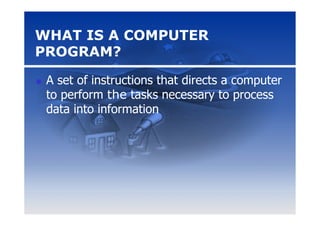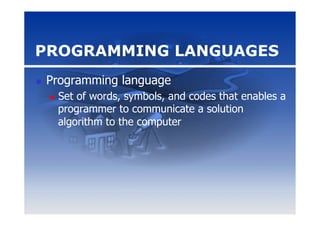Programming language
- 1. Programming Language Marisa Paryasto
- 2. OBJECTIVES n Explain the differences among the categories of programming languages n Identify programming languages commonly used today n Identify the uses of application generators, macros, and RAD tools n Describe various Web page development tools, including HTML, DHTML, and XML
- 3. WHAT IS A COMPUTER PROGRAM? n A set of instructions that directs a computer to perform the tasks necessary to process data into information
- 4. PROGRAMMING LANGUAGES n Programming language n Set of words, symbols, and codes that enables a programmer to communicate a solution algorithm to the computer
- 5. PROGRAM DEVELOPMENT TOOLS n User-friendly software products designed to assist in the creation of information system solutions
- 6. CATEGORIES OF PROGRAMMING LANGUAGES n Machine languages n Assembly languages n Third-generation languages n Fourth-generation languages (4GL) n Natural languages
- 7. Low Level Versus High Level n Low level n is written to run on one particular computer n High level n can run on many different types of computers
- 8. Machine languages n Also known as first-generation language n Machine language is referred to as level languages n Instructions use a series of binary digits (1s and 0s) n The only language that the computer directly understand n Disadvantage n Tedious to code program n Time consuming n Program is machine dependent
- 9. Example of machine languages
- 10. Assembly languages n instructions are written using abbreviations and codes n Also referred as low-level languages n Writes codes such as A for addition, C for compare n Programmer can refer to storage locations with symbolic addresses n Machine dependent n Source program n Program containing the assembly language code n Macros n Generate more than one machine language instruction n Needs translator (assembler) to convert program into machine codes
- 12. Third-generation languages n Instructions, which use a series of English-like words n Are procedural languages because the computer must be told what to accomplish and how to do it. n Needs translator to convert program into machine codes n Compilers n Interpreters n Object code or object program n The machine language version that results from the compiling the 3GL
- 13. Example of a Compiler
- 14. Example of a Interpreter
- 15. Fourth-Generation Languages (4GL) n Which also uses English-like statements n Is a nonprocedural language because a programmer only specifies what the program should accomplish without explaining how. n Syntax (rules of the language) are to be followed n Machine independent
- 16. Example of SQL
- 17. Natural languages n Is a type of query language that allows the user to enter requests resembling human speech.
- 18. OBJECT-ORIENTED PROGRAM DEVELOPMENT n Programmers create objects n Classes n Subclasses n Superclasses n Inheritance
- 19. OBJECT-ORIENTED PROGRAM DEVELOPMENT n Object-Oriented Programming n Object-oriented programming (OOP) language n Event-driven
- 20. POPULAR PROGRAMMING LANGUAGES n BASIC n Visual Basic n Design the graphical user interface n Write code for program events n Generate the application n COBOL
- 21. POPULAR PROGRAMMING LANGUAGES n C n C++ n FORTRAN n Pascal n Ada n RPG (Report Program Generator) n Other programming languages
- 22. PROGRAM DEVELOPMENT TOOLS n Application generators (program generators) n Form builders (screen painters) n Menu generator
- 23. PROGRAM DEVELOPMENT TOOLS n Macros n Recording macros n Writing macros n Running macros n RAD Tools: Visual Basic, Delphi, and PowerBuilder n Visual Basic n Delphi n PowerBuilder
- 24. WEB PAGE PROGRAM DEVELOPMENT n HTML n Hypertext markup language (HTML) n Tags (markups) n Resulting Web page n Scripts, Applets, and Servlets n Common gateway interface (CGI) n Counter n Image map n Processing form
- 25. WEB PAGE PROGRAM DEVELOPMENT n Java, JavaScript, and Perl n Java n JavaScript n Perl n Dynamic HTML (DHMTL) n Allows more graphical interest and interactivity in Web pages n Style sheets n XML n eXtensible Markup Language n May replace HTML
- 26. MULTIMEDIA PROGRAM DEVELOPMENT n Multimedia authoring software n Used to display text, graphics, animation, audio, and video into an electronic interactive presentation
- 27. SELECTING A PROGRAMMING LANGUAGE OR PROGRAM DEVELOPMENT TOOL n Standards of the organization n Interface with other programs n Suitability of the language to the application n Portability to other systems
- 28. SUMMARY OF PROGRAMMING LANGUAGES n Categories of programming languages n Object-oriented program development n Popular programming languages n Program development tools n Web page program development n Multimedia program development




























